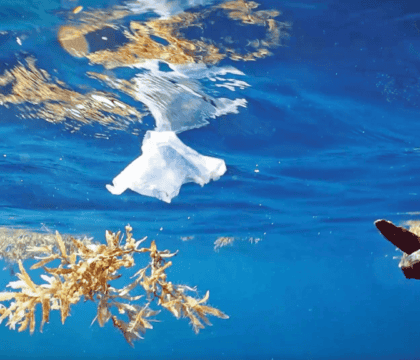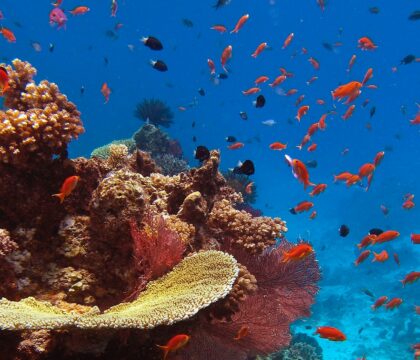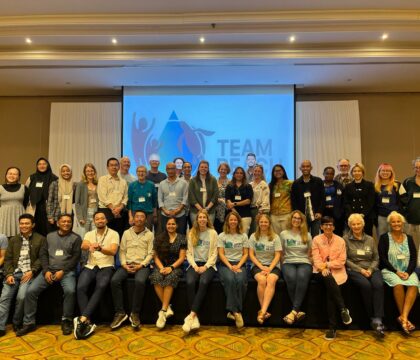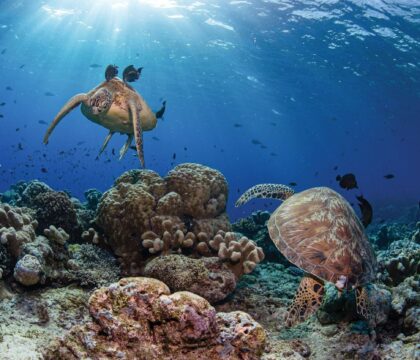February 2, 2023 • Blue Habits Tips, Ocean Facts
Coral reefs are one of the most biologically and economically important ocean ecosystems. Sadly, they are also one of the most threatened. In this guide we will explore the relationship between coral reefs and climate change, one of the leading causes of coral reef decline. We’ll also discuss ways that you can help save coral reefs every day.
Topics covered include:
- What are coral reefs?
- Are corals plants or animals?
- What is coral bleaching?
- Why are coral reefs important?
- How does climate change impact coral reefs?
- How can I help save coral reefs?
- What can I do about climate change?
Coral Reefs and Climate Change: An Introduction
Coral reefs have existed on Earth for 500 million years, providing shelter and food to many generations of ocean life. Although they cover less than 1% of the ocean floor, coral reefs support an estimated 25% of all marine species. Not only do they play an essential role in supporting healthy oceans, they also come in a candy store variety of spectacular shapes, sizes, and colors, from enormous patterned mounds to small, delicate lacy forms.
Abundant hard corals in Palau. © Keoki Stender
Today, coral reefs face a multitude of human-caused threats that include pollution, overfishing and destructive fishing, mismanaged tourism, and the impacts of climate change. In fact, scientists estimate that we’ve already lost as much as half of all coral reefs since 1980, and some fear that we could lose the rest in just 30 years. Fortunately, there are actions we can take to reduce our impacts on corals and the marine life that depends on them, and some corals—super corals—have shown resilience to anthropogenic stressors. Now is the time to become part of the movement to protect these vital ecosystems.
What Are Coral Reefs?
Coral reefs are created when many corals grow together in the same area. There are two main types of corals, hard corals, and soft corals. Stony corals, or hard corals, are reef-building corals. They have hard calcium carbonate skeletons that provide the structure that helps hold coral polyp colonies together. Soft corals on the other hand are soft and bendable, and have a wood-like core and fleshy exterior. They often resemble trees or plants. Though coral reefs are characterized by the presence of many coral growing together, they are home to a very wide diversity of life forms beyond corals that include visually-similar species like anemones, sea fans, sponges, and sea squirts, as well as fish, crustaceans, mollusks, and many, many other species.
Most coral reefs are found in shallow, tropical or semi-tropical habitats where they enjoy warm waters and ample sunlight year-round. In fact, reef-building corals cannot tolerate waters below 64°F (18°C). However, coral reefs are not only found in these areas—there are even coral reefs in the deep sea!
Colorful soft corals in Palau. © Keoki Stender
Are Corals Animals or Plants or Rocks?
Although they may look like plants or rocks, corals are colonial animals, with most made up of thousands of polyps. Like sea anemones and jellies, they are cnidarians and have specialized cells that can sting.
Most corals rely on zooxanthellae for survival. Zooxanthellae are algae that have symbiotic relationships with corals and other cnidarians, like sea anemones. They live within the tissues of corals, and come in an array of dazzling colors that give coral reefs their spectacular rainbow hues. Corals provide shelter and nutrients that zooxanthellae need for photosynthesis, and, in turn, zooxanthellae provide the corals with oxygen and carbohydrates that are produced through photosynthesis.
Bleached corals appear ghostly white. The biggest cause of coral bleaching is rising ocean temperatures due to climate change. © Ocean Image Bank
What Is Coral Bleaching?
Coral bleaching is a process by which corals and anemones lose their zooxanthellae, and, with them, their color. Bleaching is a stress response that can be triggered due to temperature changes (too hot or too cold), too much or too little light, changes in salinity, or other stressors. Today, the biggest cause of coral bleaching is rising ocean temperatures. When ocean temperatures increase, zooxanthellae can be damaged or expelled. Bleaching is not always fatal, but it can lead to disease and death, because, as discussed in the previous section, corals and anemones rely on the zooxanthellae to survive.
Why Are Coral Reefs Important?
Beyond their intrinsic value and the roles they play in supporting vast numbers of marine species, coral reefs also provide many functions that benefit people. They help prevent coastal erosion, offer protection from storm surge, and support jobs ranging from fishing to tourism. It’s estimated that the economic value of coral reefs is at least $30 billion per year, but most likely much higher, and more than 500 million people worldwide rely on coral reefs for food, income, coastal protection, and more.
The economic value of coral reefs is estimated to be at least $30 billion (USD) per year, © Grant Thomas / Ocean Image Bank
How Does Climate Change Impact Coral Reefs?
Coral reefs are feeling the heat from climate change. As ocean temperatures rise, the warm waters can cause coral to stress and expel their zooxanthellae (a process known as bleaching, as explained above). Without zooxanthellae, corals are susceptible to illness and death. Recent research has found that the frequency of large-scale coral bleaching events (“mass bleaching”) has increased dramatically in the last 40 years, to the point that corals often have insufficient time to recover between bleaching events. Thankfully, some coral reefs (including those in Raja Ampat, Indonesia) have shown resilience to coral bleaching, but it is unclear what impacts future warming will bring.
In addition to warming waters, excessive amounts of carbon dioxide in the atmosphere can harm coral reefs through a process called ocean acidification. Oceans can absorb about 30% of atmospheric carbon dioxide, but as the amount of carbon dioxide in the atmosphere increases, it can actually lower the pH level of seawater, causing it to become more acidic. Corals, in particular those with calcium carbonate skeletons, require near-perfect conditions to grow and flourish. If the ocean water is too acidic, corals may struggle to build their skeletons and the base structure for many coral reefs.
How Can I Help Save Coral Reefs?
Regardless of where you live, your choices impact coral reefs. The way we get around, how we use energy, our food choices, and many other aspects of our lives directly contribute to greenhouse gas emissions that are warming our planet. Millions of people worldwide are already taking action to fight climate change, and you can join them through a variety of actions ranging from simple lifestyle changes, to how you vote, where you shop, and more. To find out how to join the growing movement of people taking action to fight climate change, visit our guide to reducing your carbon footprint. Your actions truly make a difference, and together we can help coral reefs persist for generations to come.
What Can I Do About Climate Change?
Given the planetary scale of climate change, it is easy to feel helpless as an individual to do anything meaningful about it. And indeed, large scale actions by governments and businesses are most urgently needed to slow the pace of global warming. At the same time, each of us has both the opportunity and moral responsibility to make a difference in our daily lives. And as it turns out, most of us vastly underestimate the importance of our individual actions in fighting climate change. To learn more about what you can do, read our comprehensive guide: What Can I Do About Climate Change? Your Questions Answered.




